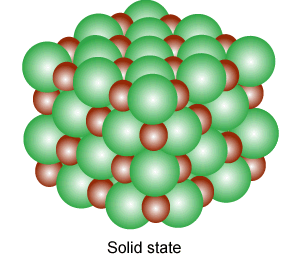Atoms of metals x, y, and z form face-centered cubic (fcc) unit cells of edge length Lx, body-centered cubic (bcc) unit cells of edge length Ly, and simple cubic unit cells of edge length Lz, respectively. If rz =\(\sqrt{\frac{3}{2}}\)ry ; ry = \(\sqrt{\frac{8}{3}}\)rx ; Mz = \(\frac{3}{2}\) My and MZ = 3Mx, then the correct statement(s) is(are)[Given: Mx, My and Mz are molar masses of metals x, y, and z, respectively. rx,ry, and rz are atomic radii of metals x, y, and z, respectively.]
- Packing efficiency of a unit cell of x> Packing efficiency of a unit cell of y > Packing efficiency of a unit cell of z
- Ly > Lz
- Lx > Ly
- Density of x > Density of y
The Correct Option is A, B, D
Solution and Explanation
Given, \(r_z=\frac{\sqrt3}{2}r_y\) and \(r_y=\frac{8}{\sqrt3}r_x\)
\(\therefore\, r_z=\frac{\sqrt3}{2}\times\frac{8}{\sqrt3}r_x=4r_x\)
\(M_z=\frac{3}{2}M_y\)
\(M_z=3M_x\)
\(\therefore M_y=2M_x\)
Packing efficiency FCC>BCC>SC
Packing efficiency unit cell x>y>z
In the FCC unit cell, \(\sqrt2L_x=4r_x\)
\(\Rightarrow L_x=2\sqrt2 r_x\)
\(\therefore \sqrt3l_y=4r_y\Rightarrow L_y=\frac{4}{\sqrt3}r_y=\frac{4}{\sqrt3}\times\frac{8}{\sqrt3}r_x=\frac{32}{3}r_x\)
\(L_y=\frac{32}{3}r_x\)
\(\therefore\,l_z=2r_z\)\(=2\times4r_x=8r_x\)
\(l_x=2\sqrt2r_x\) and \(l_y=\frac{32}{3}r_x\)
\(\therefore l_z=8r_x\)
\(\therefore\,l_y>l_z>l_x\)
density of x = \(d_x=\frac{zM_x}{(L_x)^3N_A}=\frac{4\times M_X}{(2\sqrt2)r_x)^3\times N_A}=\frac{M_X}{4\sqrt2 r^3xN_A}\)
density of y = \(d_y=\frac{zM_y}{(L_y)^3N_A}= \frac{2\times2M_X}{(\frac{32}{3}R_X)^3N_A}=\frac{108M_X}{32768r^3_xN_A}\)
\(\therefore\) density of x > density of y
Top Questions on The solid state
- In a metal deficient oxide sample, MXY2O4(M and Y are metals), M is present in both +2 and +3 oxidation states and Y is in +3 oxidation state. If the fraction of M2+ ions present in M is \(\frac{1}{3}\), the value of X is______.
- JEE Advanced - 2024
- Chemistry
- The solid state
- A metal 𝑀 forms hexagonal close-packed structure. The total number of voids in 0.02 mol of it is _______ $×10^{21}$. (Nearest integer).
( Given $N_A=6.02×10^{23}$)- JEE Main - 2023
- Chemistry
- The solid state
A cubic solid is made up of two elements $X$ and $Y$ Atoms of $X$ are present on every alternate corner and one at the enter of cube $Y$ is at $\frac{1}{3} td$ of the total faces The empirical formula of the compound is
- JEE Main - 2023
- Chemistry
- The solid state
- What fraction of one edge centred octahedral void lies in one unit cell of fcc?
- NEET (UG) - 2023
- Chemistry
- The solid state
- A cubic solid is made up of two elements $X$ and $Y$ Atoms of $X$ are present on every alternate corner and one at the center of cube $Y$ is at $\frac{1}{3} rd$ of the total faces. The empirical formula of the compound is
- JEE Main - 2023
- Chemistry
- The solid state
Questions Asked in JEE Advanced exam
- Let \(\frac{\pi}{2}<x<\pi\) be such that \(\cot x=\frac{-5}{\sqrt{11}}\). Then
\((\sin\frac{11x}{2})(\sin 6x-\cos6x)+(\cos\frac{11x}{2})(\sin 6x+\cos 6x)\)
is equal to- JEE Advanced - 2024
- Trigonometric Identities
- Let f(x) be a continuously differentiable function on the interval (0, ∞) such that f(1) = 2 and
\(\lim\limits_{t→x}\frac{t^{10}f(x)-x^{10}f(t)}{t^9-x^9}=1\)
for each x > 0. Then, for all x > 0, f(x) is equal to- JEE Advanced - 2024
- Differential equations
- Two large, identical water tanks, 1 and 2, kept on the top of a building of height H, are filled with water up to height ℎ in each tank. Both the tanks contain an identical hole of small radius on their sides, close to their bottom. A pipe of the same internal radius as that of the hole is connected to tank 2, and the pipe ends at the ground level. When the water flows from the tanks 1 and 2 through the holes, the times taken to empty the tanks are t1 and t2, respectively. If \(H = ( \frac{16}{ 9} ) ℎ\), then the ratio t1/t2 is ___
- JEE Advanced - 2024
- Escape Speed
- A student appears for a quiz consisting of only true-false type questions and answers all the questions. The student knows the answers of some questions and guesses the answers for the remaining questions. Whenever the student knows the answer of a question, he gives the correct answer. Assume that the probability of the student giving the correct answer for a question, given that he has guessed it, is \(\frac{1}{2}\) . Also assume that the probability of the answer for a question being guessed, given that the student’s answer is correct, is \(\frac{1}{6}\) . Then the probability that the student knows the answer of a randomly chosen question is
- JEE Advanced - 2024
- Probability
- Let \(k\in R\). If \(\)\(\)\(\)\(\lim\limits_{x→0+}(\sin(\sin kx)+\cos x+x)^{\frac{2}{x}}=e^6\), then the value of k is
Concepts Used:
Solid State
Solids are substances that are featured by a definite shape, volume, and high density. In the solid-state, the composed particles are arranged in several manners. Solid-state, in simple terms, means "no moving parts." Thus solid-state electronic devices are the ones inclusive of solid components that don’t change their position. Solid is a state of matter where the composed particles are arranged close to each other. The composed particles can be either atoms, molecules, or ions.

Types of Solids:
Based on the nature of the order that is present in the arrangement of their constituent particles solids can be divided into two types;
- Amorphous solids behave the same as super cool liquids due to the arrangement of constituent particles in short-range order. They are isotropic and have a broad melting point (range is about greater than 5°C).
- Crystalline solids have a fixed shape and the constituent particles are arranged in a long-range order.



